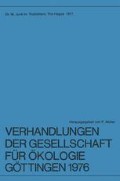Abstract
The biomass of the two most abundant chilopod species, Lithobius mutabilis L. Koch and Lithobius curtipes C. Koch, has been determined in an about 130 years old Luzulo-Fagetum in the Solling, a forest area about 50 km north-west of Göttingen, Federal Republic of Germany.
Inside research area Bla litter samples were taken from March 1972 to July 1974 on sites a, b, c, from March 1974 to July 1975 on sites A, B, C, and extracted in a Kempson apparatus. Sites a and b were the most northerly and about 2m higher than sites A and B, approximately 150 m south of them. Sites c and C lay about 40 m south-easterly of a and b.
I have determined the width of the cephalic shield (Hw), fresh weight (fw), and dry weight (dw) of field lithobiids and set up regressions of \(\sqrt[3]{{fw}}\) to Hw and fw to dw (Tab. 1). The Hw of the extracted animals could be measured and thus their biomass determined (Fig. 1 and 2). Distribution of biomass has been tested either by t-test or analysis of variance after logarithmic transformation of data.
Neither of the two species showed significant differences in biomass between different years on the same sampling site. Biomass against time showed no maxima and minima in the course of the year for L. mutabilis. From March 1974 to July 1975 L. curtipes has a significantly higher biomass in the warmer half of the year (March-August) than from September to February. The biomasses of both species show significant differences between the sampling sites, especially in the case of L. curtipes (Tab. 2). Biomass of L. curtipes is higher the more southerly and therewith deeper the sampling sites. There exists a correlation between biomass of L. curtipes and abundance of spiders. Where L. curtipes biomass is high spider abundance is generally low and vice versa. From all years and sites the mean annual abundance and biomass of L. mutabilis can be calculated as 41 ind./m2 and 113.1 mg dw/m2, of L. curtipes as 32 ind./m2 and 38.5 mg dw/m2 (Tab. 3). This value is very similar to the biomass of each spiders and predacious coleoptera in the same area. It is compared with abundance and biomass figures for lithobiids found by other authors (Tab. 3).
Ergebnisse des Solling-Projektes der DFG (IBP). Mitteilung Nr. 131.
Access this chapter
Tax calculation will be finalised at checkout
Purchases are for personal use only
Preview
Unable to display preview. Download preview PDF.
Literatur
Albert, R. (1973): Spinnenfauna zweier Buchenflächen des Soiling. Unveröffentjiche Diplomarbeit, Göttingen. 60 S.
Albert, R. (1977): Struktur und Dynamik von Spinnenpopulationen des Soiling. Verh. Ges. Ökologie, Göttingen 1976. S. 83–91. Junk, Den Haag, 83–91.
Eason, E.H. (1964): Centipedes of the British Isles. F. Warne and Co., London. 294 S.
Ellenberg, H. (1971): Introductory Survey. In: H. Ellenberg, Hrsg., Integrated Experimental Ecology. Ecol. Studies 2: 1–15.
Gerlach, A., Krause, A. & Meisel, K. (1970): Vegetationsuntersuchungen im Soiling. Schriftenr. Vegetationsk. 5: 75–78.
Grunert, J. (1974): Untersuchungen zur Biologie und ökologischen Energetik zweier Sta-phyliniden — Populationen im Soiling. Unveröffentlichte Diplomarbeit, Göttingen. 49 S.
Hartmann, P. (1977): Struktur und Dynamik der Staphylinidenpopulationen des Soiling. Verh. Ges. Ökologie, Göttingen 1976. Junk, Den Haag, S. 75–81.
Huhta, V. & Koskenniemi, A. (1975): Numbers, biomass and community respiration of soil invertebrates in spruce forests at two latitudes in Finland. Ann. Zool. Fennici 12: 164–182.
Kempson, D., Lloyd, M. & Ghelardi, R. (1963): A new extractor for woodland litter. Pedobiologia 3: 1–21.
Roberts, H. (1957): An ecological study of the arthropods of a mixed woodland with particular reference to the lithobiidae. Ph.D. Thesis, University of Southampton. 200 S.
Weidemann, G. (1971): Food and energy turnover of predatory arthropods of the soil surface. In: H. Ellenberg, Hrsg., Integrated Experimental Ecology. Ecol. Studies 2: 110–118.
Weidemann, G. (1972): Die Stellung epigäischer Raubarthropoden im Ökosystem Buchen-Wald. Verh. dt. zool. Ges., 65. Jahresversammlung, S. 106–116.
Wignarajah, S. (1968): Energy dynamics of centipede populations (Lithobiomorpha, L. crassipes and L. forficatus) in woodland ecosystems. Ph.D. Thesis, University of Durham. 168 S.
Author information
Authors and Affiliations
Editor information
Rights and permissions
Copyright information
© 1977 Dr W. Junk bv Publishers The Hague
About this chapter
Cite this chapter
Albert, A.M. (1977). Biomasse von Chilopoden in einem Buchenaltbestand des Solling. In: Müller, P. (eds) Verhandlungen der Gesellschaft für Ökologie, Göttingen 1976. Springer, Dordrecht. https://doi.org/10.1007/978-94-011-5957-9_9
Download citation
DOI: https://doi.org/10.1007/978-94-011-5957-9_9
Publisher Name: Springer, Dordrecht
Print ISBN: 978-90-6193-568-1
Online ISBN: 978-94-011-5957-9
eBook Packages: Springer Book Archive

